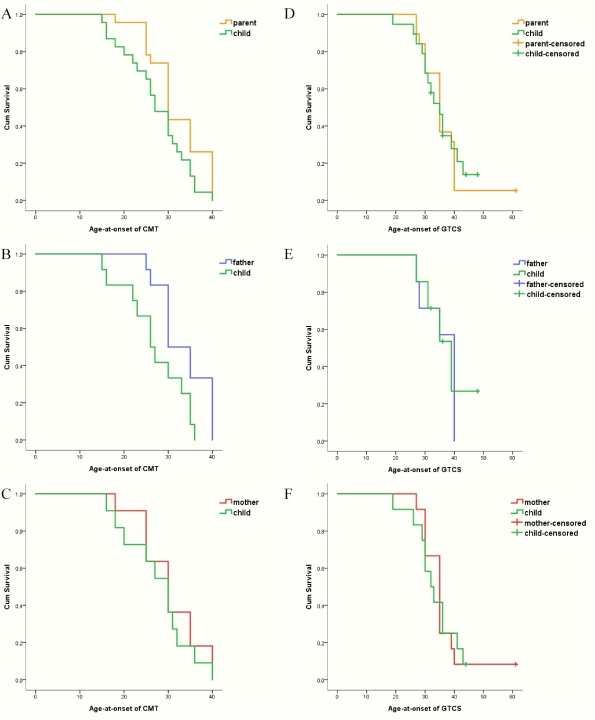Session Information
Date: Thursday, June 23, 2016
Session Title: Clinical trials and therapy in movement disorders
Session Time: 12:00pm-1:30pm
Location: Exhibit Hall located in Hall B, Level 2
Objective: To delineate and analyze the clinical and neurophysiologic features of 55 patients from nine Chinese familial cortical myoclonic tremor with epilepsy (FCMTE) pedigrees.
Background: FCMTE is a rarely reported genetic epilepsy syndrome, whose causative gene is still uncertain and detailed clinical and neurophysiologic features need further study.
Methods: Detailed clinical and neurophysiologic data were obtained. Cortical myoclonic tremor (CMT) severity was evaluated by simplified myoclonus rating scale. Somatosensory evoked potential (SEP) amplitudes and clinical profile (include age at examination, gender, disease duration of CMT, CMT severity, experience of generalized tonic-clonic seizures (GTCS) and use of antiepileptic drugs (AEDs)) were analyzed using multilevel statistical models. Age-at-onset anticipation was analyzed using Kaplan-Meier survival analysis.
Results: Of the 55 patients included, 41 had experienced GTCS. SEP amplitudes were significant higher in patients with higher level of CMT severity (χ2 = 13.384, p = 0.0003) and in patients using AEDs (χ2 = 5.922, p = 0.0150)  . CMT severity was significantly higher in patients with longer disease duration of CMT (χ2 = 7.535, p = 0.0061). The median age at onset of CMT was 30 ± 1.36 (SE) years (95% CI = 27.34-32.66) in parents and 27 ± 1.92 (SE) years (95% CI = 23.24-30.76) in their children, with a significant difference (χ2 = 4.75, p = 0.029). The median age at onset of CMT was 30 ± 2.60 (SE) years (95% CI = 24.91-35.09) in fathers and 26 ± 2.31 (SE) years (95% CI = 21.47-30.53) in their children with a significant difference (χ2 = 5.24, p = 0.022)
. CMT severity was significantly higher in patients with longer disease duration of CMT (χ2 = 7.535, p = 0.0061). The median age at onset of CMT was 30 ± 1.36 (SE) years (95% CI = 27.34-32.66) in parents and 27 ± 1.92 (SE) years (95% CI = 23.24-30.76) in their children, with a significant difference (χ2 = 4.75, p = 0.029). The median age at onset of CMT was 30 ± 2.60 (SE) years (95% CI = 24.91-35.09) in fathers and 26 ± 2.31 (SE) years (95% CI = 21.47-30.53) in their children with a significant difference (χ2 = 5.24, p = 0.022)  .
.
Conclusions: This is the largest cohort of FCMTE patients ever reported. Some clinical and neurophysiologic features were analyzed and some statistic significances were obtained, which were uncertain in previous reports because of the limited number of patients. According to our results, SEP amplitudes could be a potential indicator of disease severity and administration of AEDs in FCMTE. The age-at-onset anticipation of CMT with parent/child and father/child pairs was statistically significant, which further confirmed a possibility of unstable expanding repeat in the genetic mechanism of FCMTE.
To cite this abstract in AMA style:
Z. Cen, C. Huang, H. Yin, F. Xie, X. Lu, Z. Ouyang, Y. Lou, X. Qiu, Z. Wang, J. Xiao, M. Ding, W. Luo. Familial cortical myoclonic tremor with epilepsy in Chinese population: Clinical and neurophysiologic features in nine pedigrees from People’s Republic of China [abstract]. Mov Disord. 2016; 31 (suppl 2). https://www.mdsabstracts.org/abstract/familial-cortical-myoclonic-tremor-with-epilepsy-in-chinese-population-clinical-and-neurophysiologic-features-in-nine-pedigrees-from-peoples-republic-of-china/. Accessed December 26, 2025.« Back to 2016 International Congress
MDS Abstracts - https://www.mdsabstracts.org/abstract/familial-cortical-myoclonic-tremor-with-epilepsy-in-chinese-population-clinical-and-neurophysiologic-features-in-nine-pedigrees-from-peoples-republic-of-china/
